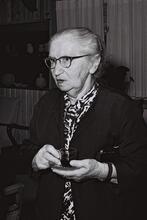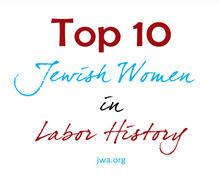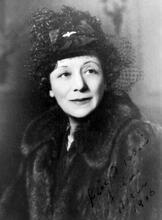Histadrut Nashim Ivriot (Hebrew Women's Organization)
Following several decades of work done by women’s organizations in Palestine, the Hebrew Women’s Organization (HWO) was formed in 1920 as an attempt to centralize the provision of aid and services to women and children in Palestine. The founding members of the Zionist organization, however, disagreed about whether it should serve poor women of the old Yishuv and Mizrahi communities or immigrants and new arrivals to Palestine. Ultimately, the HWO did both, offering services ranging from legal aid and evening classes to lessons in nutrition and nursery care. Financially reliant on the American organization Hadassah and feeling pressure from other older and larger Zionist women’s organizations, the organization merged with WIZO in 1933.
Women’s Organizations in Palestine before HWO
Though the Hebrew Women’s Organization was founded in Palestine only in 1920, a great deal of women’s activism preceded it by several years, both on A voluntary collective community, mainly agricultural, in which there is no private wealth and which is responsible for all the needs of its members and their families.kibbutzim and in cities and settlements.
The years after World War I and the Balfour Declaration, which followed the British takeover of Palestine from the Turks, were the beginning of a new era in the building up of Palestine. The Zionists felt in their bones that 2,000 years of exile were coming to an end, and in this thrilling atmosphere set to work to build the national homeland.
This turning point in the life of the Jewish community in Palestine prior to the establishment of the State of Israel. "Old Yishuv" refers to the Jewish community prior to 1882; "New Yishuv" to that following 1882.Yishuv especially affected women, who had hitherto taken little part in public life. In 1917 and 1918, women in the cities and settlements formed unions which were called “Women’s Associations,” which may be seen as the beginning of the women’s movement in the country. The first such group, the Hebrew Women’s Association, was formed in Jerusalem immediately after the city was taken from Turkish control in December 1917. Similar organizations were formed in 1918 in Jaffa, Tel Aviv, Petah Tikvah, and Rishon le-Zion and, after the northern part of the country was liberated, in Haifa. These associations, which were completely independent of each other, had very similar goals: they aimed to gather women from all ethnic communities in order to engage in public work under the national-Zionist banner.
What was unique about these goals was that, unlike the women’s movements founded in other countries, the demand for political, professional, and cultural equality between the sexes was not a high priority. There were several reasons for this, the most important of them being the fact that, at the time, the demand for equality between the sexes was not of sufficient importance to attract women. The men who lived under Mandate rule did not enjoy equal rights either. On the other hand, public work in an immigrant-absorbing country with a heterogeneous population was a challenge of the highest importance. The women’s associations took much of this challenge upon themselves and continue to do so today.
However, when the new British regime, unlike its Ottoman predecessor, sought to make the country’s inhabitants active partners in government institutions, the problem of women’s political equality became acutely relevant, the ensuing dispute being primarily between the new Yishuv and the old. The women’s associations which engaged mainly in absorption and social work now relegated these issues to the background and turned their main efforts to the struggle for the right to vote and to run for office. In the end, they won. Yet once women’s electoral rights had been achieved, the political questions lost their allure for most women (except for the members of The Union of Hebrew Women for Equal Rights in Erez Israel), and women’s associations slowly ceased operation.
However, these associations were not the first instance of women’s activity in Palestine. They had been preceded by the Ezrat Nashim organization, which was founded by H. Z. Pines, who inter alia established the hospital for the mentally ill and incurable in Jerusalem in 1902. There was also the Ezer Le-Yoldot organization, and the welcome work of Sarah Thon, who from 1911 founded workshops for Lit. "Eastern." Jew from Arab or Muslim country.Mizrahi women skilled in lacemaking and weaving, thus providing them with an opportunity to improve their quality of life.
Women agricultural workers began to organize in 1914 and when the Histadrut General Trade Union was established in 1920 they integrated with the workers’ movement. At the Histadrut’s assembly a decision was made to elect a women workers’ council. The goal of this body was to encourage independent action among women workers, develop their awareness of their value as human beings and allow them to reveal their talents in various areas.
The Founding of the Hebrew Women’s Organization
The Hebrew Women’s Organization (HWO) was the brainchild of Bat-Sheva Kesselman, a native of Odessa who immigrated to the United States, where she joined Hadassah, and from there moved to Palestine with her husband in 1919, settling in Jerusalem. Troubled by the high infant mortality rate, the lack of medical hygiene and the poverty of most of the women giving birth, Kesselman dreamed of founding an organization that would remedy the situation. Despite the objections of many prominent women in the Yishuv, she held a large public assembly of women in Jerusalem’s Beit ha-Am on May 21, 1920. Spirits were high and favorable at the gathering, and then and there a large committee was formed to ensure the establishment of the organization and begin work. Even so, the announcement of its formation was worded very carefully, since Henrietta Szold was in the country at the time and everyone, including Bat-Sheva Kesselman, felt that it was only right that Henrietta Szold head the new organization. Szold, who visited Palestine for the first time in 1909, founded Hadassah in 1912 as a Zionist women’s movement whose goal was to raise the level of medical care and hygiene in the country. In 1920, at the age of sixty, Szold moved to Palestine and Bat-Sheva Kesselman asked her to lead the HWO. Szold consented and became the first chairwoman of the Hebrew Women’s Organization.
Thereafter, and until the HWO merged with the Women’s International Zionist Organization (WIZO) in 1933, the HWO had seven chairwomen, including Henrietta Szold (1920–1924), Nellie Mosensohn (1924–1925), Dr. Helena Kagan (1925–1927), and Hannah (Helena) Thon (1927–1928). At the end of 1928, a tripartite leadership was formed comprised of Bat-Sheva Kesselman, Bat-Sheva Katznelson and Emma Esther Smoira (1889–1951). From 1929 to 1933 Esther Smoira served as the sole chairwoman. She continued to act as chairwoman when HWO merged with WIZO and remained in that position until her serious illness in 1941.
The first meeting of the HWO was held on July 14, 1920, in the Amdursky Hotel in Jerusalem with more than a hundred women in attendance. Even at that first meeting, there were differences of opinion regarding the goals of the HWO: the assembly’s decisions determined that the goal was to extend “aid to new immigrants and residents of the country” in general, though the invitation to the assembly referred only to “the good of mothers and children in Jerusalem.”
These two directions indicated very different outlooks. The slogan “For the good of mothers and children” meant public aid, which was needed mainly by the old Yishuv and the Mizrahi communities, who were still remote from the Zionist enterprise or at least had not taken an active part in it. The supporters of this approach perceived the work of remedying the condition of the underprivileged strata of society as a clearly Zionist endeavor. Others wished to direct the activities of the new women’s organization toward building the country and felt that it should work mainly for new immigrant women.
In the continuing dispute between these two approaches, those who demanded public aid for needy women often won out. However, aid to new immigrant women was in fact undertaken with the arrival of the large waves of immigration. Since even Szold, Mosensohn, and Kesselman were very strongly connected with Hadassah, the aid work focused mainly on new mothers and their babies. As the babies grew, the older children were also included. In any case, activity at the outset was dedicated mainly to aid and not to promoting women’s status or equal opportunity.
The Development of Operations and Their Characteristics
Although Jerusalem remained the center of all its activity, by 1928 the HWO boasted nine additional branches throughout the country, located respectively in Haifa, Tiberias, Tel Aviv, Rehovot, Petah Tikvah, Rishon le-Zion, Nes Ziyyonah, Haderah, and Hebron.
The areas of operation were, respectively:
Supervision of pregnant women—The Mothers’ Committee: Jerusalem, Tel Aviv; assistance with budget and work at Hadassah clinics: Hebron, Rehovot, Rishon le-Zion, Haifa, Jerusalem, Tel Aviv, Petah Tikvah; sewing workshop: Rehovot, Haifa, Jerusalem; evening classes: Rehovot, Jerusalem; legal aid: Rishon le-Zion, Petah Tikvah; nutrition for kindergarten children: Rehovot, Rishon le-Zion, Haifa, Jerusalem, Tel Aviv, Petah Tikvah; provision of milk for babies: Haifa, Jerusalem, Tel Aviv, Petah Tikvah; clothing distribution: Haifa, Jerusalem, Tel Aviv, Petah Tikvah; kindergartens: Haifa (three); Jerusalem (three); Tel Aviv (one); schooling: Jerusalem; baby home: Jerusalem; nursery care: Tel Aviv.
The country’s first organization to deal in social work, the HWO even fought to change it from a voluntary occupation into a profession. When the Yishuv elected its representatives for the third time in 1931, the Hebrew Women’s Organization, together with the Union of Hebrew Women for Equal Rights (with which it had cooperated several times in the past), presented its own list of candidates and ran for office. Its goal was to found a social work department as part of the Va’ad Le’ummi (National Council). This goal was achieved in full and Henrietta Szold was chosen to head the department. There is no doubt that the creation of infrastructure for the social work profession was one of the HWO’s greatest achievements.
The HWO did not neglect cultural activity. From its founding, it held Hebrew classes and lectures on various topics of interest to women or which the organization felt should interest them. In 1926, when the organization decided to publish a “Monthly Magazine on Women’s Issues,” they wrote to Hadassah, requesting a budget allocation. At first conceived as a one-time publication, it later appeared regularly. Hannah (Helena) Thon was appointed editor of The Woman, which dealt not with practical work but rather with women’s political struggle. In its articles, the publication argued in favor of women’s political rights, reported on the struggle for women’s rights in the Yishuv as a whole and in other countries, and clarified the question of Jewish women’s rights from the religious and traditional point of view. The journal also dealt with the issue of “women’s internal liberation,” meaning freedom from prejudices, inhibitions and outmoded ways of life, and thus tried to re-educate members according to modern concepts and norms.
In 1920, the same year that the HWO was founded in Palestine, the Women’s International Zionist Organization (WIZO) was founded in London, where the central office of the Zionist Organization was located. This was a women’s movement that paralleled the Zionist Organization and its goal was to aid and advance women in Palestine. Vera Weizmann and Rebecca Sieff were among its founders.
Although WIZO’s work was dedicated entirely to Palestine, there was no WIZO federation in Palestine. Similarly, the Hadassah movement, which had been founded in the United States in 1912 by Henrietta Szold, had no federation or women’s movement activity in Palestine, engaging only in medical work. In contrast, the Mo’ezet ha-Po’alot (the General Council of Women Workers, which in 1976 changed its name to Na’amat) increased its activity considerably, as did the Union of Hebrew Women for Equal Rights and the Mizrachi Women’s Organization, which later became the Emunah movement (see also Religious Zionist Movements in Palestine). The two large Zionist women’s movements founded outside Palestine made great efforts to form a women’s movement native to the country and at first the HWO even had a close connection with Hadassah, receiving the lion’s share of its budget from that American movement (of which Henrietta Szold was also the chairwoman). The World WIZO Center, on the other hand, captivated by the Mo’ezet ha-Po’alot, whose activity suited the romance of Zionism in the Lit. (Greek) "dispersion." The Jewish community, and its areas of residence, outside Erez Israel.Diaspora, cooperated a great deal with that organization. WIZO even established a national council in Palestine whose task was to supervise the growing number of WIZO institutions in the country, but it did not manage to develop into a general women’s movement, mainly because of the vibrant activity of the HWO. The two movements were very similar to each other. Both appealed to urban middle-class women and their goals were almost identical.
The HWO reached the conclusion that it could not continue to remain financially dependent upon Hadassah. It wished to do its own fundraising, mainly in Europe, but WIZO, which was active there, did not allow it to encroach on its fundraising sources.
For some seven years, exciting and exhausting negotiations were conducted regarding a possible merger between WIZO, Hadassah, Mo’ezet ha-Po’alot and the HWO. The story of these negotiations reads like a suspense-filled thriller. Finally, WIZO and the HWO decided to merge. In 1933, the HWO changed its name to the Zionist Women’s Organization and became the Palestinian Federation of World WIZO.
Gerber, Vardit. “An American in Palestine: Henrietta Szold and the Establishment of Social Services During the British Mandate Period, 1920-1945.” Ph.D. dissertation, Haifa University, 2016.
Smoira, Esther. Nashim ʻIvriyot Tsiyoniyot: sipurah shel "Histadrut nashim ʻIvriyot" mi-yom hiṿasdah bi-shenat 1920 ṿe-ʻad hafikhatah la-federatsyah ha-Yiśreʼelit shel Ṿitso bi-shenat 1933 (Hebrew Zionist Women: The Story of the Hebrew Women’s Organization from its Founding). Tel Aviv: WIZO, 2002.











